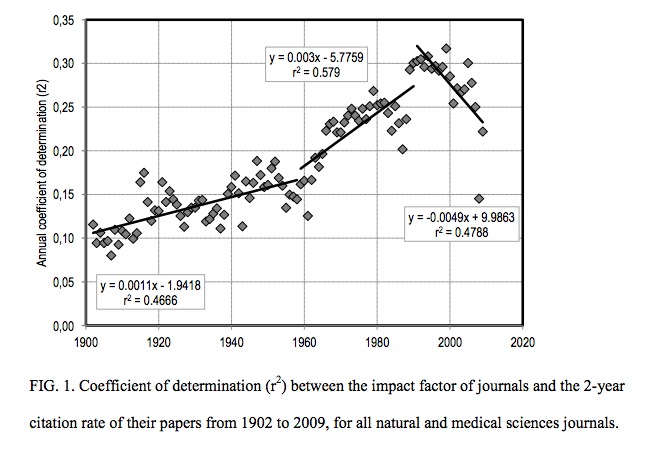Here’s an interesting piece from George Lozano showing that, while journal impact factor became an increasingly better predictor of citation rate of a paper until 1990, over the last two decades, that relationship has begun declining. Figure 1 (below) is particularly interesting.
Category Archives: Links to Outside Reading
A Discussion of Post-Publication Peer Review in EEB
I got asked to take part in this hangout a few weeks ago – no connection to our working group. My comments, though, are definitely heavily informed by what we talked about last week. I did make sure not to tip my hand, though! There’s a lot here, and it was interesting to see how three other young eco/evo types were pretty onboard with a lot of what we have been talking about.
(also, enjoy Lorie’s cameo banging)
TechCrunch on Peer Review and the Future of Publishing
Here are two that I fell across recently from Richard Price (the academica.edu founder at TechCrunch that are pretty in sync with our group
1) The Future of Peer Review – he outlines why crowd and social review may well be better than our current three two sometimes one person review system.
2) The Future of Science – Price pretty much arrives right where we are. Interesting.
Keep your eyes on F1000 research
It appears that F1000 research has added a number of new features since their initial announcement. They are still Gold (as in author pays) but, their current about blurb reads:
“F1000 Research is a new fully Open Access publishing program across biology and medicine, that will start publishing later this year. It is intended to address the major issues afflicting scientific publishing today: timely dissemination of research, peer review, and sharing of data. Diverging from traditional journal publishing, F1000 Research will offer immediate publication; open, post-publication peer review; open revisioning of work including ongoing updates; and encourage raw data deposition and publication. In addition, F1000 Research will accept a broad range of article formats and content types.”
(emphasis mine)
I’ll be very interested to see the final form this all takes. There’s no reputation economy associated, but, they appear to be firmly on the right track.
Thoughts?
Related broader efforts
During the week we made plenty of reference to other things out there, but, as we start researching a bit more precisely how we want to implement this effort, it would be nice to hear some more thoughts on exactly how this fits in with other efforts out there.
A few things to focus attention on (but please mention others as well):
PeerJ is interesting but obviously still a giant unknown, which we spent plenty of time speculating about.
figshare has a lot of what we talked about in spirit: a place to publish and cite all kinds of objects. Although textual objects can be put there, the emphasis there is on visual objects, so it doesn’t match quite as well with our conversational focus. But it seems to me whatever we build should include linking to figshare in a nice, integrated way.
PaperCritic by Mendeley is at the other end of the spectrum, totally focused on peer review of actual papers. It doesn’t serve as a place to actually post papers, however. Its usefulness seems intimately tied to how Mendeley-ized your life is, and I think there are both benefits and obvious drawbacks to this. And certainly it’s as unpervasive in the culture as anything else.
Also, Lonnie’s question of why exactly did Nature Precedings fail seems to me very important. Without actually knowing anything, I suspect it’s the lack of a focused community.
New experiment in mathematics: a “forum”, not a journal.
The Forum of Mathematics
This looks like a hybrid approach to avoiding the false scarcity of print journals when porting publication to the web.
http://gowers.wordpress.com/2012/07/02/a-new-open-access-venture-from-cambridge-university-press/
UC white paper on the future of scholarly communication
Ginsparg on peer review
“If we were to start from scratch today to design a quality-controlled archive and distribution system for scientific and technical information, it could take a very different form from what has evolved in the past decade from pre-existing print infrastructure. Recent technological advances could provide not only more efficient means of accessing and navigating the information, but also more cost-effective means of authentication and quality control. I discuss relevant experiences of the past decade from open electronic distribution of research materials in physics and related disciplines, and describe their implications for proposals to improve the implementation of peer review. ”
http://people.ccmr.cornell.edu/~ginsparg/blurb/pg02pr.html#_jmp0_
Collaboration readiness
Hi,
Thanks for allowing me to sit on this morning – cool stuff.
Here are those refs to work on collaboration readiness:
Olson, G. M. & Olson, J. S. (2000). Distance Matters. Human-Computer Interaction, 15(2/3), 139-178.
Olson, G.M., Teasley, S., Bietz, M. J., & Cogburn, D. L. (2002). Collaboratories to support distributed science: the example of international HIV/AIDS research, Proceedings of the 2002 annual research conference of the South African institute of computer scientists and information
Easy,
JP
Aggregated Science Blogging on One Page
I can put you in touch with at least one of the folk on the coding team if you’re interested in adopting the system for something.

